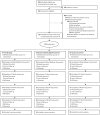Project HERO: a randomized trial of Tai Chi qigong versus intensity-matched exercise and usual care for fatigue in older male cancer survivors
- PMID: 40616105
- PMCID: PMC12228344
- DOI: 10.1186/s12906-025-04988-7
Project HERO: a randomized trial of Tai Chi qigong versus intensity-matched exercise and usual care for fatigue in older male cancer survivors
Abstract
Background: Fatigue is often one of the most commonly reported symptoms in older male cancer survivors, but it is also one of the least understood cancer-related symptoms. Fatigue is associated with psychological distress, disruptions in sleep quality, and impairments in health-related quality of life. Thus, elective treatments for fatigue in older male cancer survivors represent a current unmet need. Prior research has shown that Tai Chi Qigong (TCQ), a mind-body exercise intervention, can improve physical and emotional health. Therefore, we compared the efficacy of Tai Chi Qigong (TCQ) versus exercise intensity-matched (EIM) and usual care in older, male cancer survivors with fatigue.
Methods: We conducted a three-arm, single-blind randomized controlled trial where older (55 + years), male cancer survivors with fatigue participated in usual care or one of two supervised group exercise programs: TCQ or EIM twice weekly for 12 weeks. Participants were followed up for 12 months. The primary outcome was patient-reported fatigue at 3-months post-intervention.
Results: A cohort of men (n = 113) were enrolled (mean age: 69.1 (±7.0) years. In the primary outcome analysis, there were no significant within-arm or between-arm differences in fatigue (p-value, NS). However, the TCQ and EIM arms showed significant within-arm improvement in fatigue immediately post-intervention (p-value < 0.05). There were no differences in class attendance for either TCQ or EIM, with an average attendance rate of 78.4% and 76.8%, respectively.
Conclusion: We found no significant or clinically meaningful improvements in fatigue for TCQ or EIM relative to usual care at the 3-month follow-up. However, significant improvements in fatigue were observed immediately after completion of the 12-week TCQ and EIM programs. This study suggests that TCQ and light intensity activity may lead to improvements in fatigue immediately after the group exercise program among older, fatigued male cancer survivors. However, the observed improvements did not persist beyond the program, suggesting that long-term maintenance may be required. Further testing is warranted in larger trials that include strategies to sustain both the behavior and the effects.
Trial registration: This study was registered at the NIH clinical trial registry on November 17, 2017 (NCT03345563).
Keywords: Cancer; Complementary therapy; Fatigue; Mind-Body therapies; Qigong; Tai Chi.
© 2025. The Author(s).
Conflict of interest statement
Declarations. Ethics approval and consent to participate: This study was performed in line with the principles of the Declaration of Helsinki. Approval was granted by the Institutional Review Board of Rutgers, the State University of New Jersey (Pro2018002020) and the University of New Mexico (HRRC #16–239). Written informed consent was obtained from all individual participants included in the study. Consent for publication: Not applicable. Competing interests: The authors declare no competing interests.
Figures


References
-
- Hilfiker R, Meichtry A, Eicher M, Nilsson Balfe L, Knols RH, Verra ML, et al. Exercise and other non-pharmaceutical interventions for cancer-related fatigue in patients during or after cancer treatment: a systematic review incorporating an indirect-comparisons meta-analysis. Br J Sports Med. 2018;52(10):651–8. 10.1136/bjsports-2016-096422 - PMC - PubMed
-
- Hofman M, Ryan JL, Figueroa-Moseley CD, Jean-Pierre P, Morrow GR. Cancer-Related fatigue: the scale of the problem. Oncologist. 2007;12(S1):4–10. 10.1634/theoncologist.12-s1-4 - PubMed
Publication types
MeSH terms
Associated data
Grants and funding
LinkOut - more resources
Full Text Sources
Medical
Miscellaneous

